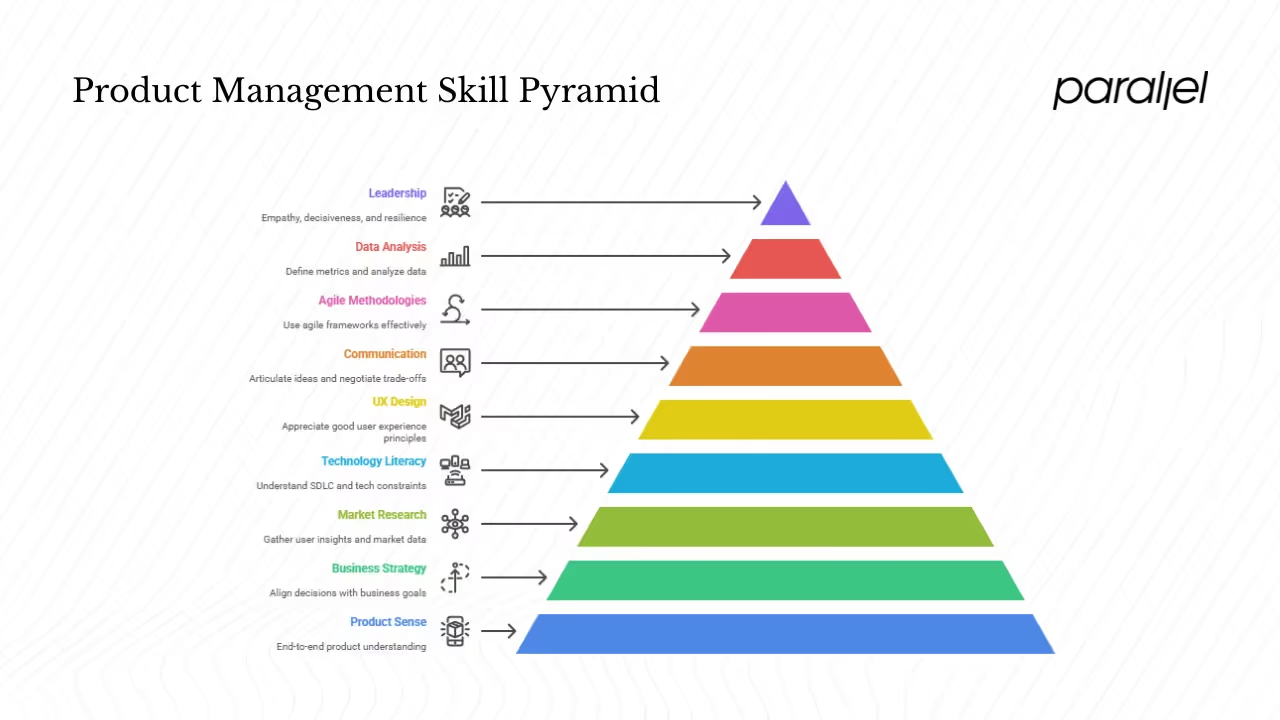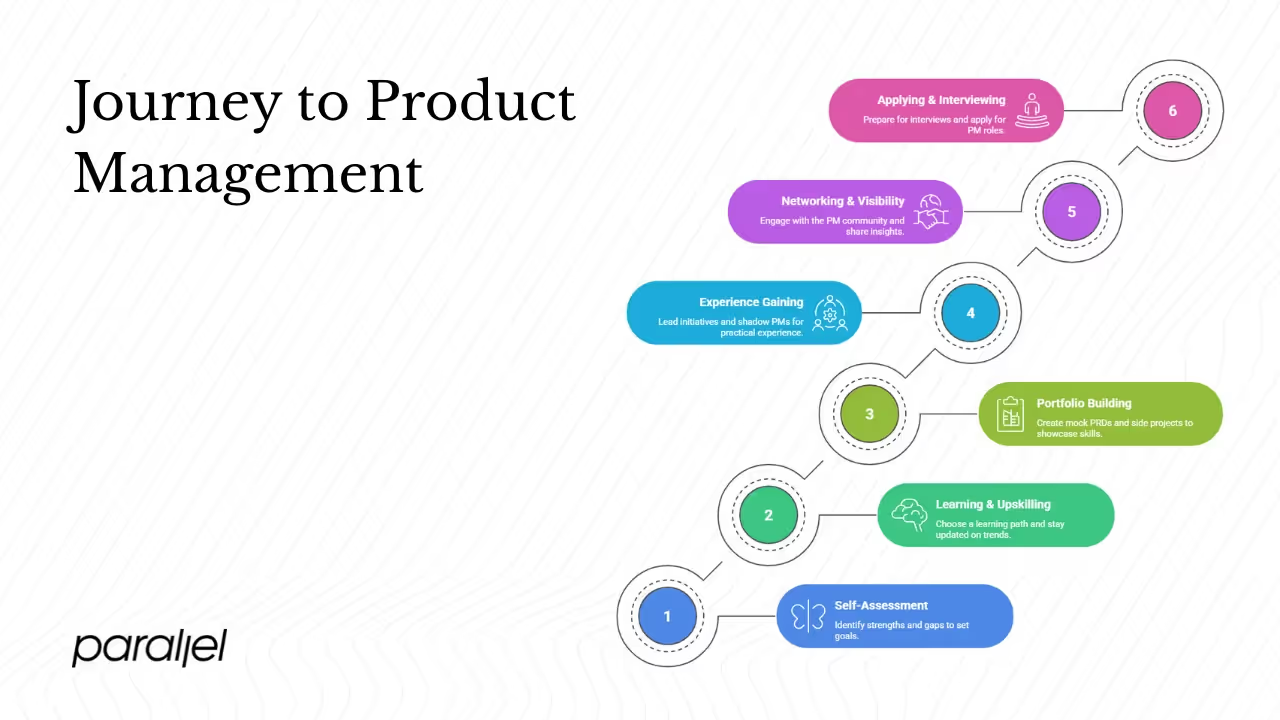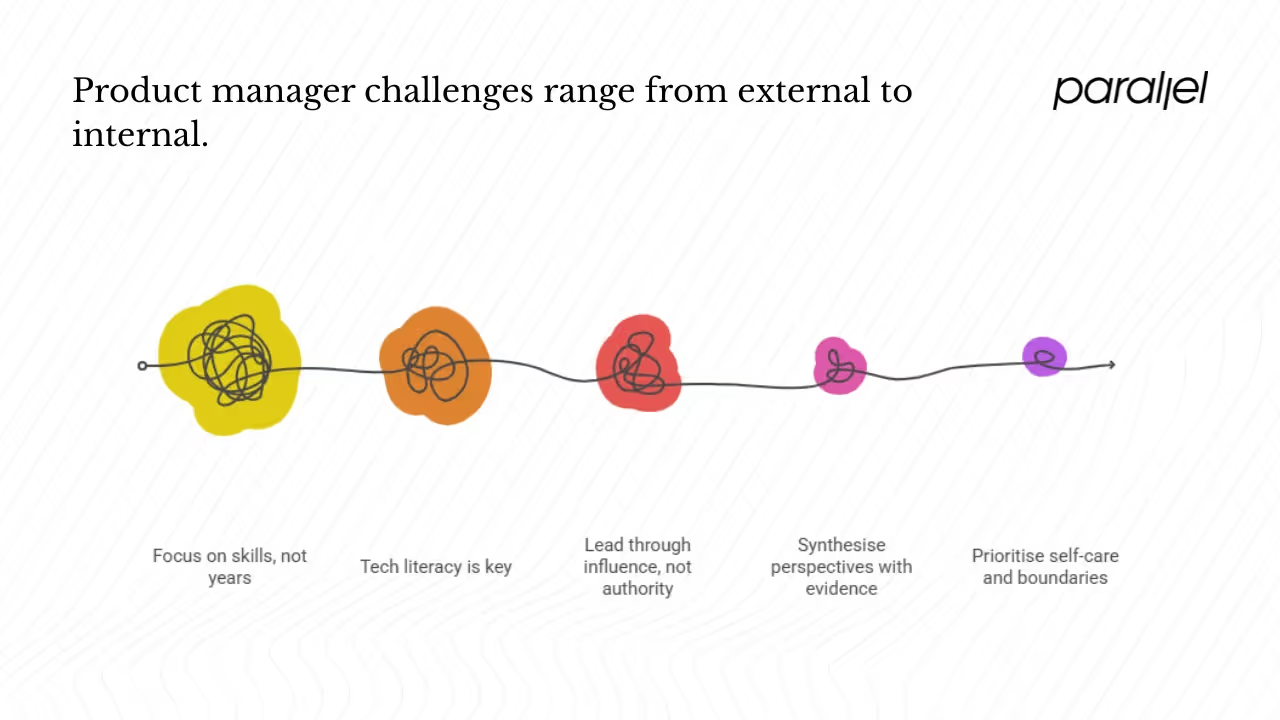How to Become a Product Manager: Complete Guide (2025)
Learn the steps to become a product manager, including essential skills, career paths, and tips for breaking into product management.

Product management is an unusual career. People arrive from design, engineering, support, or even philosophy. I made that jump myself more than a decade ago when a client asked me to “think through the product” rather than just the interface. At that moment I had to learn how to become a product manager, and I quickly learned that the answer isn’t found in a job description—it’s found in doing the work.
Most of the advice you see on the internet either oversimplifies product management or overloads it with jargon. That doesn’t help when you’re at an early‑stage start‑up, juggling design, tech, and business decisions with a tiny team and a shrinking runway.
This guide aims to demystify the role for founders, designers, developers, and anyone wondering how to become a product manager. I’ll share what we’ve learned at Parallel working with AI/SaaS teams, reference research and data from respected sources, and provide a roadmap that prioritises practice over theory.
What does a product manager actually do?
A good product manager sits at the crossroads of business, design, and technology. The Aha! product management guide summarises the core scope well: a product manager sets strategy, evaluates ideas, prioritises features, defines releases, builds roadmaps, and reports on progress. These activities run through the entire product lifecycle—from research and concept to launch and ongoing iteration.
At Parallel we often describe the role as the “glue” between disciplines. You aren’t the boss; you’re the person who frames the customer problem, aligns the team around a vision, and ensures the work delivers value to users and to the business. The Nielsen Norman Group notes that product managers draw on strategic thinking, strong communication, and decisive action while managing backlogs, studying business data and trends, and documenting progress.
Key responsibilities
Your core responsibilities typically include:
- Customer and market research – talk to users, run surveys, and analyse trends. Use qualitative methods (interviews, usability tests) and quantitative data to uncover needs and pain points.
- Defining vision and strategy – articulate why the product exists and how it will evolve. Productboard describes this as mapping a long‑term vision and aligning it with business goals, supported by market research and customer insights.
- Prioritising features and releases – decide what to build next based on impact and effort. This involves trade‑offs and often saying no.
- Working with design and engineering – collaborate with UX designers, writers, and developers to translate ideas into solutions. You act as a translator between users, the business, and technology.
- Go‑to‑market and iteration – coordinate marketing and support teams for launches, then collect feedback and improve the product.
Product manager vs. project manager vs. product marketing
A product manager shapes why and what to build, while a project manager focuses on how and when work gets done. Project managers drive timelines, budgets, and risks; product managers define vision and prioritise outcomes. Product marketing managers craft messaging and position the product in the market. Understanding the distinctions helps manage expectations.
Above all, product managers influence without direct authority. As the “Clever PM” blog points out, the myth of the product manager as the CEO of the product is misleading: CEOs lead through authority, whereas product managers lead through influence, building coalitions to move the product in the right direction.
Core skills and traits you must build
Great product managers aren’t born; they’re made through deliberate practice. Here are the key skill buckets to work on.

1) Product sense and domain understanding
See the product end‑to‑end, from vision to delivery. Translate between user needs, business goals, and technical constraints. As Productboard notes, product managers are bridges between customers, developers, and stakeholders. Develop product sense by obsessing over the problem, not the solution. Spend time with users, understand their motivations, and develop a strong point of view on what will move the needle.
2) Business strategy
Product decisions must tie back to the business. Learn how your company makes money, how pricing works, and what levers affect revenue. Understand conversion funnels, retention metrics, and customer acquisition costs. Being able to articulate the business case behind each feature makes you a more credible leader and a better partner to the founders.
3) Market research and customer needs analysis
Gathering insights from users is a foundational skill. Run interviews, surveys, and ethnographic studies to understand pains and behaviours. Perform competitive analysis and market sizing—you need to know where your product sits in the landscape and how big the opportunity is. Make research a habit, not a project.
4) Software development lifecycle and technology literacy
You do not need to be a developer to be a great product manager. Product School notes that most PM roles don’t require a computer science degree. However, you must be comfortable talking to engineers and understanding constraints. Familiarise yourself with SDLC phases (planning, development, testing, deployment, maintenance) and common architectures. Curiosity is your best friend.
5) User experience design
While you may not design screens yourself, you need to appreciate what makes a good experience. Learn the basics of UX: wireframes, user flows, information architecture, and usability testing. Work closely with designers and participate in usability tests to improve empathy.
6) Stakeholder communication and leadership
Product managers spend a large share of their time communicating. Productboard emphasises that effective communication is the cornerstone of successful product management. You must articulate ideas clearly, facilitate debates, negotiate trade‑offs, and present the roadmap to executives. Build trust across functions by listening deeply and being transparent. The Nielsen Norman Group highlights strategic thinking, communication and decisive action as essential strengths.
7) Agile methodologies
Modern product teams often use agile frameworks like Scrum or Kanban. You should understand how sprints, stand‑ups, retrospectives and backlog grooming work. Agile is a mindset: deliver value early, learn from feedback, and iterate. Userback notes that in 2025 agile and lean methods will continue to dominate.
8) Data analysis and problem‑solving
Data is your compass. Define clear metrics and Objectives & Key Results (OKRs), use analytics tools, and run A/B tests. Productboard highlights the need for data analysis skills to diagnose issues and make informed decisions. Even basic SQL or spreadsheet proficiency can help you uncover patterns. Pair numbers with narrative—context matters as much as the metric.
9) Leadership and soft skills
Great product managers bring empathy, listening, decisiveness, resilience, and the ability to handle ambiguity. Cultivate patience, curiosity, and a growth mindset. Being kind and clear goes a long way in building strong teams.
Common paths and career journeys to becoming a PM
Typical backgrounds and transitions
There is no single blueprint for how to become a product manager. Many folks transition from:
- Engineering and development – they understand technology deeply but need to build customer empathy and business acumen.
- Business, consulting, or strategy – they excel at market analysis and business models but need to learn UX and delivery.
- Design or research – they bring strong user understanding and design thinking but must add tech literacy and commercial awareness.
- Operations, support, or project management – they know processes and stakeholder management but need to develop product sense.
Case examples and stories
On Reddit and in our network we’ve seen people move from QA to integrations to product management, or from customer success to PM. A colleague shadowed a PM while working in support; she documented customer pain points and suggested improvements, eventually becoming an associate PM. Another friend built an internal tool in his spare time and persuaded leadership to create a formal PM role for him.
Formal vs. informal routes
Some companies offer Associate Product Manager (APM) programs. Others prefer internal transfers—volunteer to lead a small project, write a feature spec or run customer interviews. Building side projects or MVPs on your own is also powerful; shipping even a tiny product gives you tangible proof of your abilities and a story to tell in interviews.
Step‑by‑step roadmap: How you can transition or start

1) Self‑assessment and goal setting
Start by identifying which domains excite you: fintech, health, developer tooling, consumer apps. Assess your strengths (e.g., design, analytics, communication) and gaps. Ask yourself: how do you become a product manager given your background? If you have design chops but weak tech literacy, focus on understanding architectures. If you’re technical but new to research, practise interviewing users.
2) Learning and upskilling
Choose your learning path based on your gaps. Take a product management course, but remember that certificates alone don’t guarantee a job. Design and build a simple app or website. Read blogs and newsletters from organisations like Nielsen Norman Group and Productboard. Keep up with industry trends.
3) Building a portfolio and proof of work
Hiring managers want to see how you think. Write mock Product Requirement Documents (PRDs) for features you’d love to see in existing products. Launch small side projects or contribute to open‑source. Document case studies showing the problem, your approach, and outcomes. Even if a project fails, showing what you learned is valuable.
4) Gaining relevant experience
If you’re already employed, volunteer to lead internal initiatives. You could co‑own a feature with an existing PM or run a discovery project. Shadow PMs in your company to see how they make decisions. Offer to take on small responsibilities in cross‑functional projects, like writing user stories or coordinating a release.
5) Networking and visibility
Reach out to other product managers. Attend local meetups or online communities. Share what you’re learning—publish articles, speak at events, or even tweet your lessons. When you talk about your work, opportunities find you.
6) Applying for PM roles and interviews
When you feel ready, start applying. Prepare for case interviews that test your problem‑solving and product sense, metrics interviews that test your ability to define and interpret metrics, and behavioural interviews that probe your collaboration style. Frame past work in product terms—highlight how you identified a problem, shaped a solution, and measured impact. Don’t be afraid to apply to roles that seem slightly out of reach; many job descriptions are unrealistic. A Teal analysis of 129k job listings found that nearly half of “entry‑level” jobs require mid‑level experience. Hiring managers often list wish lists rather than essential requirements.
Challenges and myths to watch out for

1) Inflated entry requirements
“3+ years experience” for an entry‑level PM job is common. Don’t let that deter you. It’s often a signalling error, not a hard rule. Focus on demonstrating product thinking and your ability to learn quickly.
2) Do you need to code?
As noted earlier, you don’t need to write code to be a product manager. Product School’s Q&A makes it clear: most PM roles don’t require a computer science degree, and coding knowledge is helpful but not mandatory. What matters is tech literacy and a willingness to collaborate with engineers.
3) The “CEO of the product” myth
The idea that the product manager is the CEO of the product sounds empowering but is misleading. Actual CEOs lead through authority; product managers lead through influence. You have to negotiate, persuade, and align without formal power. Embrace that nuance.
4) Scope creep and stakeholder conflicts
Without clear priorities, teams can drift. Learning to say no and reframe conversations around outcomes is essential. Conflicts will arise between sales, engineering, design, and leadership. Use evidence—user research, data, and business cases—to mediate. Your job is to synthesise perspectives, not to please everyone.
5) Burnout risks
Product management can be draining. You’re constantly context‑switching, handling ambiguous problems, and managing expectations. Userback warns that burnout will become a prevalent issue in 2025; product managers must prioritise self‑care and set boundaries. Recognise your limits, delegate when possible, and maintain a support network.
What to expect in the early years as a PM
First 90 days
In your first three months you’re not expected to redesign the product. Instead:
- Learn the product inside out—use it daily, read past documentation, understand the metrics.
- Meet stakeholders—engineers, designers, sales, support—and listen to their perspectives.
- Understand the business—ask leadership about goals, revenue streams, and key customers.
- Identify quick wins—small improvements or bugs that can build trust and momentum.
Measuring success as a junior PM
Success isn’t about shipping features; it’s about delivering outcomes. Define metrics with your manager and track them. For instance, you might focus on reducing onboarding time by 20% or increasing activation rates. Celebrate learning moments as well as wins.
Growth path
Titles vary, but a typical path goes from Product Manager to Senior PM to Group PM or Head of Product. Each step involves more scope and more leadership. In the early years, focus on mastering the basics: research, prioritisation, communication. The rest will follow.
Mistakes to avoid
Common pitfalls include falling in love with your solution, ignoring data that contradicts your assumptions, and taking on too much. Resist the urge to please everyone. Stay customerfocused and be honest when you’re wrong.
For founders and startup leaders: Hiring or structuring your first PM role
When to hire a product manager
If you’re a founder juggling customer discovery, feature prioritisation, and team coordination, you may be acting as the product manager by default. Hire a dedicated PM when you start to feel stretched thin—usually after product–market fit when you need to scale. Bringing in a PM too early can add unnecessary process; too late and you risk strategic drift.
What to look for
Look for someone with a bias toward action, empathy for users, and the ability to work across functions. Domain knowledge is useful but not the only factor. In early‑stage environments, generalists thrive; they can pivot between research, strategy, and execution.
Defining the scope in small teams
Be explicit about the PM’s responsibilities. In a lean team, they might handle everything from discovery to launch; in a growing team, they might focus on a specific feature set. Align on decision rights—what they own versus what remains with the founders.
Working with your PM
Treat your PM as a partner, not an order taker. Share context, include them in strategic discussions, and listen to their insights. When founders and PMs collaborate closely, the product benefits from both the visionary perspective and the grounded, user‑driven perspective.
Future trends in product management

Data and AI‑driven decisions
Userback’s 2025 trends highlight the growing influence of AI. Product managers are increasingly using AI tools to automate tasks, analyse data, and optimise decisions. This technology will continue to reshape the role, but ethical considerations and inclusivity remain important.
Product‑led growth (PLG)
PLG focuses on using the product itself to drive acquisition and retention. Userback emphasises that adopting a PLG model requires aligning the entire organisation around delivering value and collaborating closely with executives. This trend means product managers need to understand growth loops, onboarding, and pricing experiments.
Data‑driven product strategy
Product managers must be comfortable working with complex data environments. Userback notes that in 2025 they will rely heavily on data to understand customer behaviour, market trends, and product performance. Data literacy isn’t just about dashboards; it’s about asking the right questions and interpreting results.
Agile all the way
Agile and lean methodologies remain the default. Being able to adapt quickly and iterate based on feedback is no longer optional. Dual‑track agile—running discovery and delivery in parallel—will become more common.
Cross‑functional fluency and specialisation
As products become more complex, PMs need deeper cross‑functional fluency. Some may specialise as data product managers, platform PMs, or AI product managers. At the same time, generalists who can connect dots across design, business, and technology remain invaluable.
Conclusion
There is no single answer to how do you become a product manager. People arrive via engineering, design, support, academia, and more. The thread that binds them is curiosity and a desire to solve meaningful problems. At Parallel we’ve observed that teams often overcomplicate their first product—adding features without clarity. Starting small, talking to users, and iterating quickly leads to better outcomes.
So, how do you become a product manager? You start by behaving like one: identify a real problem, bring people together to solve it, measure the impact, and learn. If you’re still asking how do you become a product manager after reading this, pick a problem you care about and write a one‑page PRD. Share it with a friend, get feedback, and refine it. Don’t wait for permission. How you become a product manager is ultimately answered through practice. Stop reading and start building.
Frequently asked questions
1) Is a product manager job high paying?
Yes, compensation can be attractive, especially in tech hubs. In the United States, the average product manager earns about $116,963 per year plus a $5,000 cash bonus. That’s roughly double the national average salary. Salaries vary widely by country; for example, the average product manager in India earns ₹11,48,889 per year, which is much higher than the national average. Beyond pay, the role offers career mobility and exposure to strategic decisions.
2) How many years does it take to become a product manager?
There is no fixed timeline. Many people transition within two to four years by leveraging their existing skills and building product experience. What matters more is your ability to think like a product manager, not the years on your résumé.
3) Is it hard to get into a product manager role?
It can be competitive, particularly at large tech companies, but it’s achievable with preparation. Develop your skills, build a portfolio, network, and show that you can do the job. Even if job listings ask for more experience than you have, remember that many entry‑level roles ask for unrealistic requirements. Focus on demonstrating value.
4) What degree do I need to be a product manager?
There is no required degree. Product managers come from engineering, business, design, psychology, and humanities. Employers care more about your skills, domain knowledge, and proof of product thinking than your diploma.


.avif)










